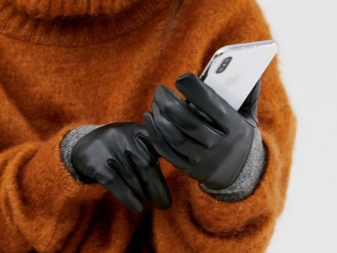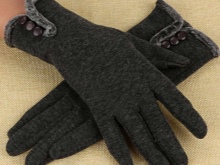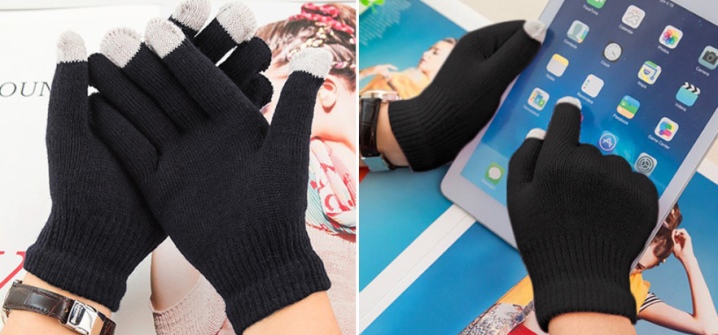All About Touch Gloves

Touch gloves: what is it, what selection of touchscreen models for smartphone screens are on the market? These questions often arise among users who first heard about a fashion accessory. Meanwhile, such innovative wardrobe items are already quite actively used by gadget lovers, allowing them to keep their hands warm even in cold weather. To learn more about them, it is worthwhile to study in more detail not only the types of gloves with special fingers for the phone, but also the principle of operation of such accessories.


What it is?
The world learned about such an invention as touch gloves for phone screens in 2006 - it was then that an accessory appeared for the first time that allows you not to bare your hands to work with a smartphone display. The development of the industry towards the release of touchscreen gadgets only spurred their popularization. Now mobile devices were needed not only for calls and typing messages.
Gloves with fingers, in which you can use all the functions of social networks, communicate in instant messengers, quickly became popular among residents of countries with cold climates.

The usual winter accessories were not suitable here - wool, fleece and other materials insulated the surface of the hand. For a smartphone with a capacitive screen, the touch remained invisible. Special gloves with fingers covered with a material visible to the sensor solved the problem. For gadgets with a touchscreen, winter accessories were proposed that used fibers that conduct an electrical signal. They are mainly made by seamless knitting from acrylic or wool, less often from leather, suede, fleece.

To indicate the sensory functions of such gloves, the sensitive areas on their surface are marked with colored elements. However, this is more of a tribute to fashion - such blocks do not affect the practical use of the accessory. Today, sensory gloves are produced in a wide range of sizes: you can find men's, women's, teenage models.
When selecting them, stocking density is very important - it determines how efficiently the signal will be transmitted.

Principle of operation
Touchscreen gloves for working with smartphones and tablets work quite simply. In addition to conventional fibers, they include special contact elements with electrical conductivity. They simulate the touch of a person's fingers, providing accurate signal transmission to the touchscreen display.
Not the entire glove has such contact properties, but only certain areas of it - they are usually located in the place of the fingertips.

In the composition of such a product, in addition to acrylic or wool, synthetic threads, conductive fibers are also indicated. Their volume in the total mass varies from 5 to 13%. The higher this indicator, the more sensitive touching the touchscreen will be. When selecting materials, only materials are used that do not adversely affect the delicate design of the touchscreen.

Species overview
It is customary to divide winter sensory gloves into categories according to the material of their production. Besides, there are distinctions according to the temperature regime of use - in inexpensive accessories, even at -10 degrees, you will not be able to use innovative functions. The best models will work in all circumstances.An additional set of options is also important: working in the mode of a bluetooth headset or headphones allows you to answer calls, listen to your favorite music without taking your smartphone out of your pocket.

Warm winter gloves with sensory functions come in several varieties.
- Woolen. Very warm, but sensitive to care. Such gloves have a comfortable fit, can stretch over time, and get wet easily.
- Acrylic. This fiber is used to make inexpensive sensor gloves. Their thermal insulation properties are average, but such products provide a good fit on the hand, confident contact with the touchscreen. This is a good solution for countries with not very cold climates; in severe frosts, you will have to look for an alternative to acrylic accessories.
- Leather. Natural material from cattle hide, sheepskin is durable, durable, waterproof. The disadvantages of such products include difficulties in sizing, and in the presence of rough seams, the electrical conductivity of the contact areas will be reduced. In addition, due to the peculiarities of the cut, they are not very comfortable when typing.
- Knitted. Combined models of different types of fibers have a seamless design, which has a beneficial effect on the contact ability of the accessory. The products are dense, retain heat well, they are comfortable and do not deform during use.
- Fleece. Quite durable and warm options, most often they are produced in a brutal design. Such gloves have the same disadvantage as leather gloves - the presence of seams that impair contact with the touch screen. With poor-quality sewing, the problem can be quite significant.



There is a certain division according to the type of design of sensor gloves. For example, in budget models, the conductive coating can be found only on the fingers of the right hand or on the tips of the thumb, middle and index. The compatibility of the accessories is also important, especially if you have the function of receiving calls via Bluetooth. In such gadgets, the "microphone" is in the little finger, and the speaker is located in the thumb - you can talk without taking out your smartphone.

Popular models
Dozens of brands offer touchscreen gloves for mobile phones today - from textile manufacturers to gadget developers. In this area, of course, there are the best models that respond to touching the screen even in severe frost., but there are also enough outsiders, to use which you have to put pressure on the display quite hard.



The most interesting proposals are worth considering in more detail.
- Mujjo. This company invented the touch-sensitive gloves, and its products are still in the premium segment even a decade later. Special attention should be paid to the leather models, which cost about $ 80. They look respectable, have excellent sensitivity, and can withstand temperatures down to -10 degrees.

- Under Armor Liner. Knitted gloves for not too cold weather. The model has a stylish design, outside there is a water-repellent coating. The multi-layer structure wicks sweat away from the hands, keeping you warm. For contact with touch screens, there are overlays on 2 fingers - thumb and forefinger.

- GliderGloves. The Canadian brand produces knitted gloves with a high level of sensory sensitivity and a modern design. Models of the brand are the leaders in the ratings in the United States according to iPhone owners. True, for harsh winters, gloves are still too thin.

- The North Face Etip. High-quality fleece gloves that fit well both in sports equipment and in the image of a modern city dweller. The fingertips have pads for using the sensor, and the palms have a non-slip silicone coating. The rear part is supplemented with reflectors.

- Fred Perry. Quality gloves made of merino wool, warming well in winter. There is a touch pad on only 3 fingers of each hand. But the model has dense multilayer cuffs.

- Barneys Original. Quality suede gloves for true fashionistas. In addition to natural material and good thermal insulation, they are also equipped with special sensitive areas on the thumb and forefinger.

- Asos Design. Budget knitted gloves in a two-tone design with a branded pattern. They warm well, fit snugly to the hand, contact surfaces are provided only for 2 fingers.

Selection Tips
When choosing touch-sensitive gloves, users have to consider a lot of factors - from the phone model to the Bluetooth version.
It should be noted right away that special accessories work exclusively on capacitive displays - resistive and without that react to any touch.
In the case of choosing gloves for the iPhone, you should immediately consider options with a Bluetooth sensor - they will allow you not to reach the device that is sensitive to cold too often to answer a call.

In addition, when looking for the optimal model of a winter accessory with sensor inserts, it is better to take into account several points.
- Manufacturing material. Thin nylon products are available for running and other sports. In other cases, it is customary to focus on the style of clothing. Leather and suede accessories are chosen for coats and fur coats. Knits and fleece are worn with down jackets and puffy jackets.
- Ease of landing. Sensory gloves should fit snugly around your hand, like a second skin. Woolen and knitwear should be taken a little smaller - they stretch when worn. Suede, leather and fleece should have a windproof wrist strap.
- Appointment. Male, teenage, female models usually have patterns that take into account the anatomical structure and size of the hand. Unisex options in most cases look much worse, have a nondescript neutral design.
- Color and ornament. Despite the winter purpose of the accessory, when choosing sensory gloves, it is better to avoid themed Christmas and New Year prints - Christmas trees, deer. The best option would be one-color products to match shoes or a bag, outerwear. If you want a variety of colors, you can find it in the form of rich wine, chocolate, olive, red shades.
- Sewing quality. It directly affects the convenience and functionality of the accessory. If the seams are skewed, the threads diverge, the edges of the material stick out - the product will not last long. In addition, it is unlikely to even sit well on the arm.
- Features of care. Conventional conductive gloves can be easily machine washed or hand washed. Models equipped with a Bluetooth-module will not tolerate such treatment.


All of these tips will be useful to those who have not yet found their perfect touch gloves or are thinking about updating existing accessories.
In the next video, you will learn about touchscreen gloves.













The comment was sent successfully.